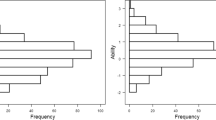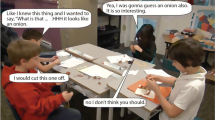Abstract
This chapter provides an overview of data from a middle school classroom analyzed by authors focusing on the constructs of argumentation, justification, and proof. The data comes from a US-based, seventh-grade (ages 12–13) lesson focusing on exploring the distributive property and the difference between supporting a claim for a finite number of cases versus an infinite number of cases. The context of the lesson, the data provided, and an overview of the whole-class discussion are described.
Access provided by Autonomous University of Puebla. Download chapter PDF
Similar content being viewed by others
Keywords
In this section, we explore particular definitions of the constructs of argumentation, justification, and proof in the context of one middle school classroom—a 7th-grade classroom in a small, somewhat rural community in New England. The school included students in grades 4–8. The teacher, at that time, had 4 years of experience. There were approximately 19 students in the class. The school did not have any grouping or tracking, and the teacher taught all sections of 7th-grade math. There were no English learners in the class.
These data were collected as part of an NSF-funded grant project. This teacher was one of 12 middle school teachers collaborating with the research team to better understand the nature of justification in middle grades classrooms. These data are from year 1 of the project. We videotaped four “lesson cycles” per teacher per year. The core of each lesson cycle was the implementation of a task designed to engage students in support-for-claims mathematical activity.
The Number Trick task was designed by the research team (cf. Porteous, 1990; Bieda, Holden & Knuth, 2006) and vetted by the project teachers. This task was the second of four such activities to be implemented during that school year as part of the research activities. We videoed the lesson and collected student work from the lesson. The data set provided to the chapter authors comprised of: (a) a transcript of the task implementation along with (b) student written work on the task (9 samples), and (c) a lesson table, to provide context for the lesson, which summarized the activity and major themes of the work students and teachers did for each of the different phases of the entire lesson. Note that the student work samples had pseudonyms, but the transcript tended to say primarily “Student 1,” “Student 2,” etc., because the original transcription process did not require that an individual’s contributions be tracked. Thus, the chapter authors could not necessarily link the student work to a student’s contribution(s) in class, although often there was a clear connection between the written work and what was said by the student. The transcribed lesson comprised the full task implementation for that class period that included the launch, individual work, small group work, and then whole-class discussion (approx. 35 min).
The task featured in the data set, the Number Trick task, was designed to engage students in ideas related to the distributive property. Students in this class had not yet been introduced to the distributive property, but they had been working to understand order of operations in previous lessons. It presented a “trick” done by Jessie, where she takes a number, does two different processes on that input, and finds that the result for both processes is the same. The two core questions focus on (1) establishing the trick for values from 1 to 10 and offering an explanation and (2) considering whether the explanation for values 1–10 demonstrates that the trick works for all values. The Number Trick task is shown in Fig. 1.
Note the unique phrasing of the second question. Students are not asked directly to demonstrate that the trick does or does not hold for any number (i.e., does the trick always work). Rather, students are asked to evaluate whether the reasoning they provided in the first part would also show that the two answers will always be the same for any number. This unconventional wording potentially opens space for a discussion about approaches to argumentation and when/what type of arguments can be used to establish a general claim versus claims about a finite set of instances.
After launching the task, students worked individually and then in small groups, with the teacher moving from group to group to ask students about their reasoning and to support them in articulating and recording their results. The teacher then selected groups, in a particular order, to share their results with the whole class. This move resonates with the idea of selecting and sequencing (Smith & Stein, 2011) although these data were collected prior to the publication of the 5 Practices for Orchestrating Productive Mathematics Discussions book. The teacher ultimately had five students share the work of their group (one student for question 1 and four students for question 2).
As the teacher transitioned from the small group work to whole-class discussion, he framed their conversation in the following way:
T: I think we all kinda came up with the same answer. That, yes, the trick will work for numbers 1 through 10. Okay. I was talking to all the groups. We all felt that it was a different… Or we all felt that it was true for numbers 1 through 10. A couple of different ways of showing it. So, I want Derek to share his method first.
The first student had checked, with his group, the numbers 1–10. The teacher highlighted this as a valid approach and then turned to the second question in the form of—does the trick always work, which is a slight, but notable, rephrasing of the question on the task. Students started offering a range of different numbers they tested (e.g., 72, 26, 451, 777, a googol).
The teacher then pressed back against this empirical approach, commenting:
T: So, we have a bunch of bigger numbers that it definitely worked for. So, we don't know, is it going to work for every bigger number? Does just trying a smathering of random numbers that are bigger, does that show me that it is going to work for every bigger number? Does that show me that it’s going to work for every bigger number?
Students proceeded to offer their ideas for the second question, in an order designated by the teacher. One group shared a theory that, because they knew that the trick “worked” for 1–10, and since all other numbers had one of those values in the ones place, the trick would work for all numbers. This proposal was refined slightly, when another student noted they would need to test 0 (which was quickly confirmed).
The teacher chose not to pursue this line or reasoning, commenting that he had not thought about that approach. He then redirected the group to share the other approach they would come up with, as he was interested in having that discussed.
This started the sharing of four different arguments addressing why the number trick would work for all values. Here is a brief summary of the arguments, numbered in the order presented:
-
1.
Grace: In the first set, we add before we multiply. And when we multiply by two, it’s going to be a bigger number. But in the second set, you multiply first. So we have to add a bigger number.
-
2.
Emma: Okay. I don’t know if it makes sense, but okay. [Reading her paper] Jessie basically in the second equation broke down the first equation. When she added 8, she might have imagined first the 8 equals 4 times 2, which she did in the first equation when she added 5 plus 4 and then doubled it. But to understand that, you must realize that 4 is still part of the equation even though it was smushed in with 5. You did double 4, but it was part of the 5 then.
-
3.
Tracie: Alright. So, if n represents any number, you’re doing n plus 4 [writing n + 4] times 2 [adding parentheses around the n + 4 and writing *2 to the right]. But that also equals n times [S: She’s taking our equation!] two plus 8 [writing (n * 2) + 8].
-
4.
Jenna comes to the SmartBoard. She writes e = # between 1 and 10 and then (e + 4)*2 = e*2 + 4*2 = e*2 + 8.
The teacher was out of instructional time at that point. He highlighted the differences in Jenna’s and Tracie’s responses (i.e., the inclusion of the intermediary step on Jenna’s), and then connected Tracie’s, Jenna’s, and Emma’s, asking what they all did that helped show the trick worked for any number. A student responded: “They gave us a letter instead of a specific number, saying that it could be any number.” The teacher reiterated the point, praised the class for its good work that day, and class ended.
References
Bieda, K., Holden, C., & Knuth, E. (2006). Does proof prove?: Students’ emerging beliefs about generality and proof in middle school. In S. Alatorre, J. L. Cortina, M. Sáiz, & A. Méndez (Eds.), Proceedings of the 28th Annual meeting of the North American Chapter of the International Group for the Psychology of Mathematics Education (Vol. 2, pp. 395–402). Mérida, México: Universidad Pedagógica Nacional.
Porteous, K. (1990). What do children really believe?. Educational Studies in Mathematics, 21(6), 589–598
Smith, M. S., & Stein, M. K. (2011). 5 practices for orchestrating productive mathematical discussions. NCTM.
Acknowledgments
These data were collected as part of a project funded by the National Science Foundation, Justification and Argumentation: Growing Understanding of Algebraic Reasoning (JAGUAR) (NSF DRL 0814829. PI Sean Larsen; Co-PIs Jill Newton, Megan Staples, & Eva Thanheiser).
Author information
Authors and Affiliations
Corresponding author
Editor information
Editors and Affiliations
Rights and permissions
Copyright information
© 2022 The Author(s), under exclusive license to Springer Nature Switzerland AG
About this chapter
Cite this chapter
Staples, M. (2022). Overview of Middle Grades Data. In: Bieda, K.N., Conner, A., Kosko, K.W., Staples, M. (eds) Conceptions and Consequences of Mathematical Argumentation, Justification, and Proof . Research in Mathematics Education. Springer, Cham. https://doi.org/10.1007/978-3-030-80008-6_7
Download citation
DOI: https://doi.org/10.1007/978-3-030-80008-6_7
Published:
Publisher Name: Springer, Cham
Print ISBN: 978-3-030-80007-9
Online ISBN: 978-3-030-80008-6
eBook Packages: EducationEducation (R0)





